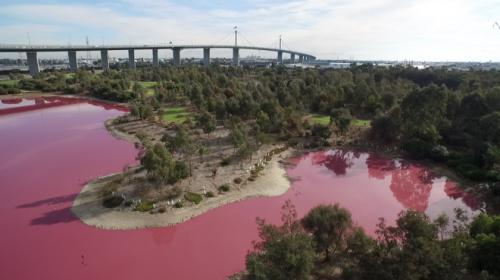(单词翻译:单击)
An Australian lake has turned a vivid pink, thanks to extreme salt levels further exacerbated by hot weather in a startling natural phenomena that resembles a toxic spill.
由于湖泊的盐分过高外加炎热的天气,澳大利亚一个湖泊的湖水变成了明亮的粉红色,这一让人吃惊的自然现象看起来像是散发着毒气。
Parks Victoria chief conservation scientist Mark Norman said last Thursday that the spectacle was the result of green algae at the bottom of the lake at Westgate Park on the outskirts of Melbourne responding to high levels of salt and changing colour.
上周四,维多利亚公园首席保育科学家马克·诺曼表示,墨尔本郊区西门公园出现的这一现象是因为湖泊的高盐分与湖中藻类盐菌及光线气温交合作用而产生的。
"The bright pink lake pops up most summers and is made by a native single-celled plant known as Dunalliela that responds to extreme levels of salt in this lake," he said, adding that hot weather makes the salt concentrate further.
他说道:“这个湖泊在夏天时经常会变成粉红湖泊,这主要是因为一种原生的单细胞植物--杜氏藻与湖泊的高盐分相互作用而产生的”。他还表示,炎热天气使盐分浓度更高。

"It's completely natural. We often get comments that it looks like an industrial accident of pink paint."
“这完全是自然现象。我们经常听到的评论是,这看起来像是发生了一起工业泄漏事故,湖水被粉红色的漆覆盖。”
The lake attracts over 140 bird species as well as many curious tourists but the authorities warned people to avoid making contact with the pink water, even though it is not dangerous.
这个漂亮的湖泊吸引了超过140种鸟类以及许多慕名而来的游客。虽然湖水看上去很漂亮,粉红色的湖水也不会造成任何危害,但有关当局还是提醒游客不要触碰湖水。
"The salt would dry as hard crystals all over your body. It would also be hard on your eyes, like sprinkling salt straight on your eyes," Norman said.
诺曼表示:“如果触碰到了湖水,在它干了之后会在你身上形成盐晶,碰到眼睛上也会造成不适,就像直接把盐撒在眼睛上一样。”


